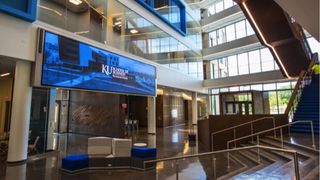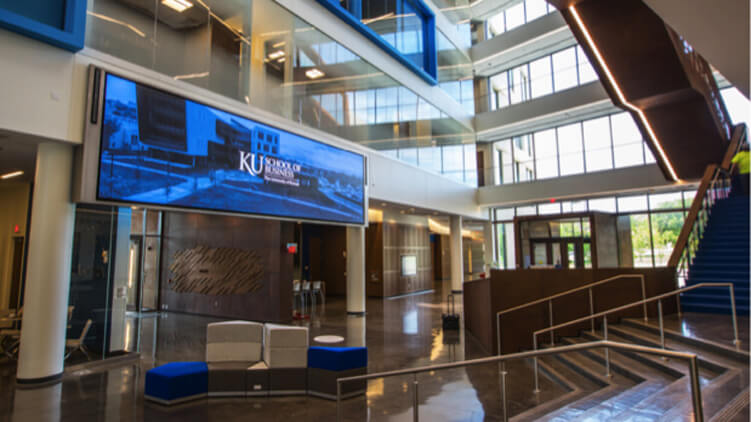When The University of Kansas (KU) began designing its new $70.5-million Capitol Federal Hall School of Business, everyone agreed that the end result had to be a building that fostered a new and higher level of collaboration between faculty, students, and visitors. The building design called for large open spaces and interconnected common areas that, by design, promoted a greater level of serendipitous interaction between all building visitors. At the same time, the administrative, architectural and design teams also agreed that the building needed an anchor, a focal point that would immediately draw everyone’s attention. That focal point turned out to be the building’s main atrium with a strategically placed coffee bar — a coffee bar anchored by two brilliant NanoLumens NanoSlim Engage LED displays.

The building project began with The University of Kansas issuing a request for qualifications to local architect and design firms. Gensler, the world’s leading collaborative design firm, andGastingerWalker&, a full-service architecture firm known for being enthusiastic about the process of design, jointly filed the winning proposal. “The building was designed to foster creativity and interaction,” GastingerWalker& Partner Dan Nenonen explained. “There are all sorts of interior spaces where students, faculty, visitors, and donors, can literally bump into each other; all of the interaction starts at the coffee bar in the main atrium across from where the NanoLumens NanoSlim Engage LED displays are positioned.”According to David Broz, Principal at Gensler, “Louis Pasteur’s quote, ‘Chance favors the prepared mind,’ served as an inspiration to the design team who operated under the belief that serendipity could not only be encouraged, it could be manufactured. The team designed flexible interior spaces that offer cues to people using them, and motivate people to connect in new ways. The design engages students by inviting authorship and offering students choice and control over where and how they learn – including the video board."
- Both NanoLumens displays feature a 2.5MM pixel pitch that enables crystal clear viewing up close and from every viewing angle, which is critical in a building featuring large open spaces. One display measures 30-feet by 7.9-feet and the second measures 15.75-feet by 3.15-feet. According to NanoLumens Director of Strategic Projects Dan Rossborough, “The building was also designed with large glass windows, which immediately eliminated the consideration of any type of projection system. Traditional LCD video walls wouldn’t work either. The only clear option was direct view LED technology and we knew we had the best offering.”
- All of the building’s audiovisual elements were designed by The Sextant Group, a nationally known independent technology consulting firm that specializes in the planning and design of collaboration, presentation, communication, and entertainment spaces. “Our role was to develop the initial AV and acoustics program and design concepts, detail the audiovisual infrastructure, finalize the technical systems design, and provide construction administration for the project,” Craig Park, Principal Consultant at The Sextant Group, said. “Although the lobby displays were not part of the original architectural concept, once NanoLumens solutions were selected, they became the centerpiece of the main atrium.”
- Rossborough added, “Once the idea of large format displays was added to the design plan, The Sextant Group knew that they needed a fine-pitch display solution that was big, making it a focal point in the building.” Once The Sextant Group showed the NanoLumens technology to the design team and school administrators —the ultimate project decision makers— the choice was clear.
- “We were looking at two different LED display manufacturers,” Nenonen continued. “However, with NanoLumens we were able to visit the manufacturing facility in Atlanta, and speak with the product engineers, programmers, and company CEO to learn more about how NanoLumens solutions are being used in other projects. The company provided us with a great capabilities presentation and was able to show us the NixelsTM, or building blocks of the display, that would be used in our project. Between the School of Business, the donor and myself, we all agreed that NanoLumens would be the best display for the long-term for the new School of Business.”
- The Kansas City-based integration company SKC Communications was selected to install the entire building’s technology, including the NanoLumens solution. “From our perspective, what stood out the most on this project was the NanoLumens overall design concept for their walls, which translated into a simple implementation,” SKC Communications Director of Marketing Lacy Fox stated.
- The NanoSlim Engage solutions play a critical role in providing daily business school, university, and national news updates for students, faculty and visitors. The displays are also used for special events hosted by the School of Business during the year.
- Broz added, “The dean and lead donor for the video board had a clear vision of enhancing the pedagogy through use of the video board. It was seen as a capstone course opportunity for a graduating senior to do a final presentation in the Atrium Space in front of the entire school on the large 30-foot display. While flipping through their presentation, the students will gain confidence to present in large spaces in front of hundreds of people.”
- Although each of the NanoSlim Engage solutions was an investment for the University, it is one that will last them for years to come. “Universities don’t have the flexibility that large corporations have when it comes to technology investments,” Park emphasized. “In projects like this, there’s no looking back and saying, ‘oh, we made a mistake. Let’s do something else.’ Once a university commits to a solution, they’re making a long-term investment they have to know they can rely upon. We have that confidence in NanoLumens.”
- Rossborough agreed, noting that, “Our NanoLumens solution will remain state-of-the-art for years to come. It has a native screen resolution that is greater than HD, so most of the canvas content is going to be the best possible, until 4K goes native on the content development side. This technology will live out its life in the School of Business and act as a centerpiece in the building until they design and develop a new business school!”










